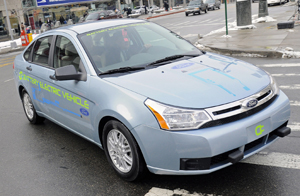
While standardization of recharging connections is essential if electric vehicles are to become commonplace, only Renault SA appears to be working actively on the idea of quickly switching a charged battery for one that is depleted in several minutes at a service station.
California-based Project Better Place, the only private company developing an infrastructure for EVs, believes such switching stations are essential to widespread public adoption.
“We need to assure the driver they will never get stuck,” Project Better Place CEO Shai Agassi says in a recent San Francisco radio interview.
Every EV manufacturer eventually will offer vehicles that can be recharged from ordinary outlets, but the typical lithium-ion battery packs with a 100-mile (160-km) range will require a 6- to 8-hour recharge.
To satisfy customers who can’t wait that long, auto makers are working on quick-charge connections that will nearly fully recharge a battery in less than half an hour. While European competitors may come up with a standard to share across borders, it could be years before a global standard is reached.
Project Better Place, which is working with Renault to bring electric cars to Israel, has installed 1,000 recharging stations in that country. By the end of 2010, just before sales of the electric Renault Megane begin there, Agassi expects to have 100,000 recharge points and 50 battery-exchange stations available.
Israel promises to be an early EV success because there is “an innate aversion to oil…embedded in everyone’s psyche,” he says.
Agassi is demonstrating a battery-exchange station this month in Yokohama, Japan, in which an arm comes up from under the car, removes the depleted battery and installs a full one.
Renault appears to be developing its first vehicles with such a system but work is not complete. The Renault Kangoo Be Bop Z.E. concept shown to Renault stockholders in Paris does not offer the system.
“We are developing three ways to recharge,” a Renault spokesman says. “Regular charge, fast charge and quick drop.” When the Kangoo comes to market in 2011, he says it will have all three.
China, like Israel and Denmark, actively is pursuing an EV industry, and Agassi says in his radio interview the U.S. and China should work together on developing an electric auto industry, rather than competing against one another.

However, while China is ambitious, it is not yet in a leadership position. Most of the new-energy concepts proposed by Chinese auto makers at the April Shanghai auto show were for micro-hybrids that use integrated starter-generators.
Only BYD Auto Co. Ltd., in which Warren Buffet has invested, has developed sophisticated EV prototypes, but the auto maker doesn’t count on rapid sales success.
“The pure electric-vehicle market will be in five to 10 years,” says Henry Li, general manager of BYD Auto’s overseas trade division, at China Automotive Review’s 14th Annual President’s Conference in Shanghai during the show.
For the next couple years, BYD will develop its plug-in hybrid cars. And the auto maker is eying Israel. “I have personally met with Shimon Peres,” Israel’s president, Li says. “Israel is a very interesting market. I am sure we are going to do something there in an early stage.”
Still, BYD’s E6 electric-car prototype is not designed for the battery quick-change approach. “BYD is working more on the quick-charging infrastructure (or home charge), rather than a battery-switching solution,” says Patrick Duan, a BYD manager. “But this is also possible in the future.”
Aside from BYD, the rest of China’s EV makers use lead-acid batteries, says Cheng Wang, research analyst at the Low Carbon Transportation Program in Beijing. “We focus on the low-cost and low-speed electric vehicles in China’s market. We believe these kinds of EVs will be the direction of the rural transportation.”
Ford Motor Co. will be the first Detroit auto maker to have a battery-electric vehicle (BEV) available when it begins selling the Focus EV in 2011. However, neither that car nor the ’10 Transit Connect light-duty van being refitted by Smith Electric Vehicles U.S. Corp. are designed to use the Project Better Place battery-exchange method.
“We are aware of the Better Place business model,” Ford spokeswoman Jennifer Moore says. Ford’s goal is “to determine the business model that will provide value for the customer and the BEV producer.”
Even Renault’s partner Nissan Motor Co. Ltd. is not developing its early electric vehicles for the battery exchange. “Nissan is privileging the plug as the technical solution for its electric vehicle,” says Nissan Europe spokesman Gilles Gautherot.
While battery switching remains an experiment that Project Better Place will execute in Israel, shared standards for fast recharging are under discussion.
In Europe, some 20 companies and the RWE electric utility in Germany are working on a fast-charge standard to be shared by auto makers. The project was announced in Hannover last month and is in progress, the Renault spokesman says.
BYD apparently is working on its own solution in China.
Getting a global agreement on standards will be difficult once investments have been made in regional or national infrastructures, but the theory of a global standard is appealing.
“We need to go for standards for electrification that are global in nature, and not regional,” says Dominik Declercq, who represents the European auto makers association ACEA in China. “Standards for plugs, charging times, billing and payments all play a part in customer acceptance.”



